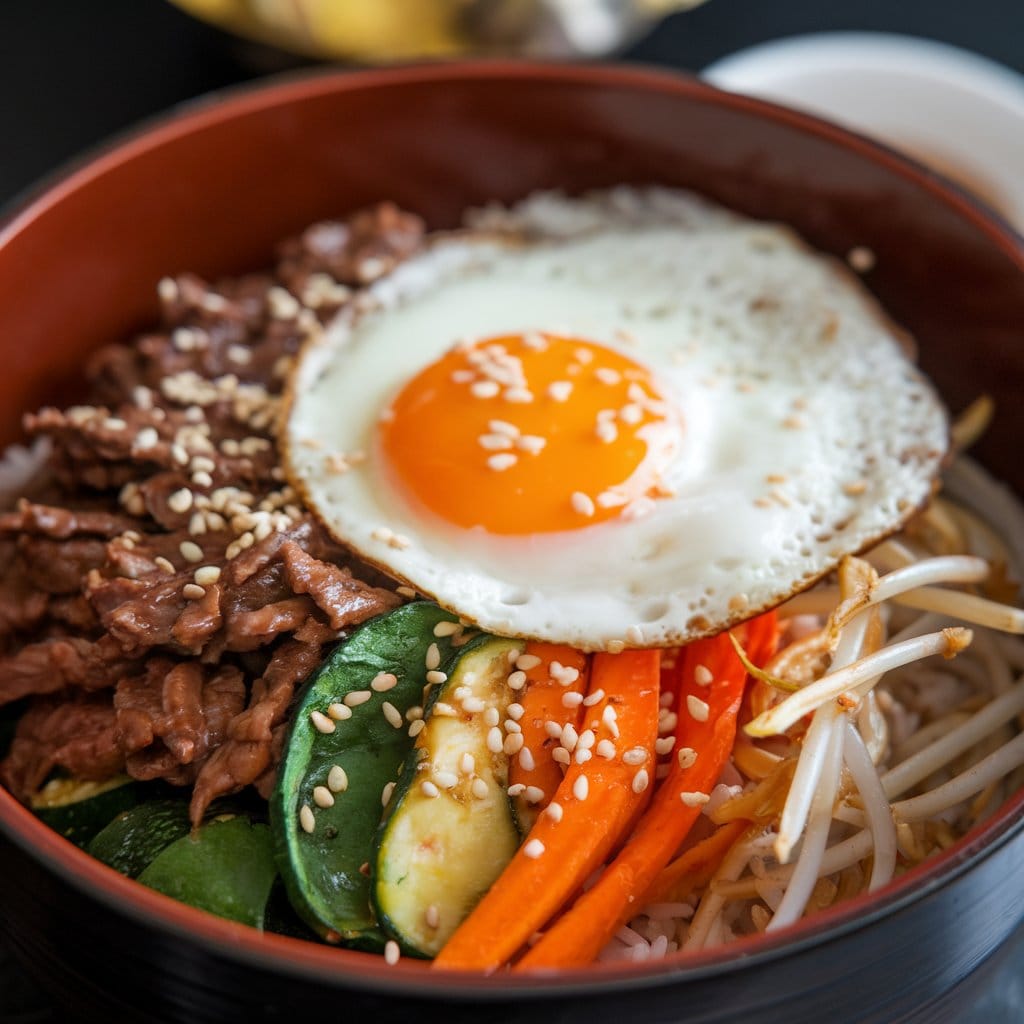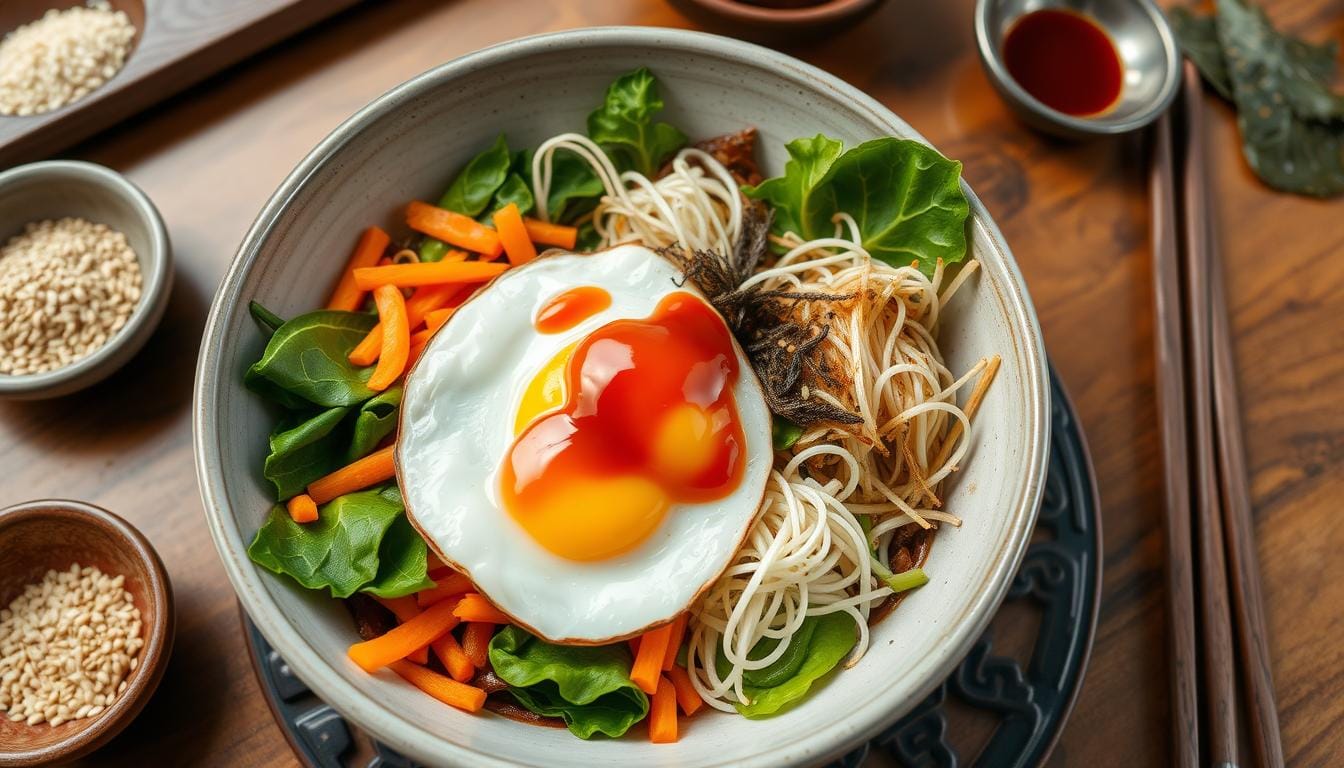Jump to Recipe
A bowl of hot bibimbap was waiting for me in a small, busy restaurant in Seoul on a cold autumn evening. It was a pleasure to eat because the brightly coloured vegetables, tasty meat, and bright gochujang sauce went so well together.
I fell in love with traditional Korean food after that, and I couldn’t wait to make that bowl at home. It may sound challenging to make bibimbap with homemade gochujang sauce, but it’s a fun and rewarding culinary adventure that combines simple ingredients with deep, complex flavours.
With the spicy kick of the gochujang and the satisfying chew of perfectly cooked rice, this Korean bibimbap recipe has a lot of different textures and tastes. There is a dish that looks appealing and tastes excellent because every ingredient adds something different to it.
What’s next? I’ll talk about the important ingredients, give you my step-by-step instructions, and give you some useful tips and tricks. We’ll discuss why bibimbap is so important to Korean food and how to make similar dishes. Grab your apron and prepare to explore this wonderful world of flavours!
Introduction to Bibimbap and Gochujang Sauce

Every time I eat Korean food, I think about the many colourful traditions that go into Korean cooking. At its core is bibimbap, a dish that not only tastes excellent but also shows some of Korea’s rich history and culture.
The history of bibimbap starts in rural Korea, where farmers would make a hearty meal out of leftovers after a long day’s work. This simple beginning turned into the elegant dish we know today, with a symphony of textures and flavours that show off the region’s rich agricultural bounty.
Gochujang sauce is an important part of this well-known dish. The ingredients of gochujang include fermented soybeans, red chilli powder, and glutinous rice. It gives bibimbap a spicy, umami flavour, which makes it better.
Because of its strong flavour and bright colour, it is an important part of Korean food and makes it look and taste better. Just like there are different kinds of bibimbap in different parts of Korea, there are also different kinds of gochujang sauce, and each one has its own unique twist.
The mix of bibimbap and gochujang sauce is still a beloved part of Korean food, whether you enjoy it in Jeonju with its traditional twist or in Seoul with its modern twist and new additions.
By learning about these things, I can learn more about the wonderful world of Korean food and enjoy the subtleties that each ingredient and cooking method brings. The next time you eat bibimbap with lots of gochujang sauce, think about the history and skill that went into making it.
Essential Ingredients for Bibimbap with Gochujang Sauce
The first step in making a great bibimbap is obtaining the necessary ingredients. Let’s look at what you need to make this really tasty Korean dish.
Main Components
Rice and vegetables are the main things that go into bibimbap. The rice gives the dish a hearty base, and the different vegetables add colour and nutrition. Spinach, bean sprouts, carrots, and courgette are all common choices.
Lightly sauté or blanche each vegetable to preserve its freshness and crunch. Because they are basic Korean foods, bibimbap is a well-balanced dish.
Making Your Own Gochujang Sauce
When you talk about bibimbap, you must mention the famous gochujang recipe. Fermented soybeans, Korean chilli paste, and sweeteners like rice syrup combine to create this sauce. It is spicy, sweet, and savoury all at the same time.
It might seem challenging to make this sauce at home, but if you follow the right steps, you can get results that are as delicious as a restaurant. All you have to do is mix the ingredients well and let them ferment to achieve a delicious depth.
Optional Toppings
Try adding different toppings to your bibimbap to make it taste better. Adding proteins like chicken, beef, tofu, or a fried egg can make the dish taste better and fill you up. You could also add pickled radish or sesame seeds to give it more taste and texture.
With this step in personalising Korean dishes, you can make your bibimbap exactly the way you want it. This turns a simple meal into a personal culinary masterpiece.
Step-by-Step Guide to Making Bibimbap with Gochujang Sauce
There are three main steps to making a tasty bowl of bibimbap with gochujang sauce: getting the vegetables ready, cooking the proteins, and putting the dish together. Follow these steps to make sure your bibimbap always turns out great.
Preparing the Vegetables
To begin, pay attention to how you prepare your Korean vegetables. Use essential ingredients such as julienned carrots and sautéed spinach. To make sure the carrots cook quickly and keep their crunch, cut them into thin strips.
To make the sautéed spinach, blanch it briefly in boiling water, then cook it with garlic and a pinch of salt to make it taste better.
Cooking the Proteins
Next, bibimbap offers a variety of protein options. The steps are the same for making bibimbap with either marinated beef or tofu. For a well-balanced marinade, mix soy sauce, sesame oil, crushed garlic, and a little sugar together. Use this on beef.
On the other hand, you can marinate tofu for bibimbap in soy sauce, garlic, and a little rice vinegar. Cook the marinated beef or tofu until it becomes fully cooked and acquires a caramelised taste.
Assembling Your Bibimbap
The last step is to layer the bibimbap to make a dish that looks good and is well balanced. In each bowl, start by putting steamed rice on the bottom. Place the julienned carrots, sautéed spinach, and other ready-made vegetables on top of the rice in separate piles.
The next step is to add either marinated beef or tofu. Finally, finish by placing an egg facing up in the middle of the bowl. Make sure the bibimbap looks appealing and inviting before serving.
Tell your customers to mix all the ingredients together and add the gochujang sauce for a unique spicy, sweet, and savoury finish. By mixing bibimbap well, you can make sure that every bite has a satisfying mix of tastes and textures.
Tips and Tricks for the Perfect Bibimbap

If you follow these helpful tips and tricks, it will be easier than you think to make the perfect bibimbap at home. Here are some useful Korean cooking tips that will make your dish taste better, starting with the rice.
Choose shortgrain rice because it has a sticky texture that is perfect for making bibimbap. If you cook it with a little less water than usual, it will be firmer. This makes it ideal for preparing the crispy base known as “nurungji.” Next, pay attention to your vegetables.
Fresh, in-season food makes a big difference in how it tastes and feels. For a real touch, season each vegetable on its own with salt, sesame oil, and a little soy sauce. This brings out the natural flavour of each ingredient and makes sure that your bibimbap has a lot of different tastes that you’ll love.
Combine soy sauce, garlic, and sugar with the proteins, be they beef, chicken, tofu, or a combination of all three. This will make the flavours stronger.
Cooking proteins until they caramelise adds a nice depth to your bibimbap.
- It will taste better if you use short-grain rice.
- Season each vegetable on its own.
- To make proteins taste better, marinate them.
- Less water in the rice will help you get a crispy base.
Putting the bibimbap together yields the best results. If you can, use a hot stone bowl. It will keep the dish warm and help to create the crispy rice layer that is so important. Just before serving, drizzle some sesame oil around the edges to make it smell and taste better.
Remember that a well-balanced bibimbap not only looks appealing but also tastes great.
Serving and Enjoying Your Homemade Bibimbap

Your beautifully prepared bibimbap is now ready for consumption. Presentation is crucial when serving bibimbap. Traditionally, we carefully place each ingredient on top of the warm rice, creating a wide range of tastes and textures.
Make sure to serve your gochujang sauce on the side so that each person can choose how spicy they want it. This makes it more fun and also takes into account different tastes. Understanding the proper way to eat Korean food can significantly enhance your bibimbap experience.
In Korean culture, eating with other people is a crucial tradition. People usually share a bunch of different banchan, which are side dishes that go well with your main dish. You can enhance the appearance of your table with bowls of kimchi, marinated vegetables, and pickled treats.
Remember to show respect by waiting for the older people to start eating before you dig into your colourful dish. This is an important part of Korean dining etiquette. And finally, enjoy the process of mixing everything in the bowl.
This action represents balance and harmony, which is what bibimbap is all about. Mix the rice, vegetables, proteins, and gochujang sauce together with chopsticks or a spoon until everything is well mixed.
Sharing these moments with family and friends transforms a simple meal into a treasured bibimbap meal experience, making every bite more enjoyable and memorable.

Korean Bibimbap with Gochujang Sauce
Ingredients
Method
- Step-by-Step Guide:
- Cook the Rice: Cook 2 cups of short-grain rice according to package instructions. Make sure it is slightly sticky.
- Prepare Vegetables:
- Blanch spinach for 1 minute, then sauté with garlic and a pinch of salt.
- Sauté carrots and zucchini separately until tender but still crisp.
- Blanch the bean sprouts briefly.
- Cook Proteins: Marinate beef or tofu in a mix of soy sauce, sesame oil, garlic, and sugar. Stir-fry until cooked through and caramelized.
- Make Gochujang Sauce: Mix gochujang, soy sauce, rice syrup/honey, sesame oil, and water. Adjust the spice level to your liking.
- Fry Eggs: Fry eggs sunny-side-up until the whites are cooked and the yolk is still runny.
- Assemble the Bowl: In a large bowl, place rice at the bottom, then arrange sautéed vegetables and proteins on top. Add the fried egg in the center, sprinkle with sesame seeds, and serve with gochujang sauce on the side.
- Mix & Serve: Mix all ingredients together with a spoon before eating.
Notes
- Feel free to customise the protein, vegetables, and spice level to your taste. Chicken, seafood, or mushrooms work well in place of beef or tofu.
- Using a stone bowl will help create the crispy rice base, also known as nurungji, for added texture.

